By Leen Randell
Updated: Jul 04, 2024
10 Best Herbal Decoctions For Cirrhosis
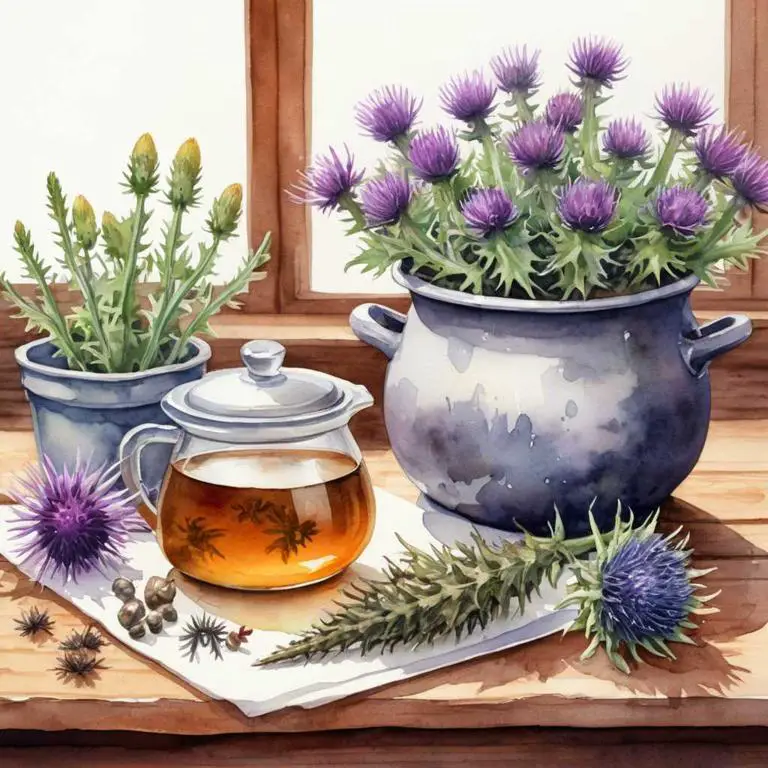
Herbal decoctions for cirrhosis are liquid extracts made from a combination of herbs, carefully selected to promote liver health and alleviate symptoms associated with cirrhosis.
These natural remedies help by stimulating liver function, reducing inflammation, and improving digestion, which can slow the progression of the disease. Examples of effective herbal decoctions include dandelion root, milk thistle, and turmeric, which have been shown to improve liver enzymes and reduce liver fibrosis.
By incorporating these herbal decoctions into their daily routine, individuals with cirrhosis may experience improved energy levels, reduced abdominal pain, and enhanced overall quality of life.
The following article describes in detail the most important decoctions for cirrhosis, including medicinal properties, parts of herbs to use, and recipes for preparations.
- 1. Silybum marianum
- 2. Glycyrrhiza glabra
- 3. Taraxacum officinale
- 4. Berberis aristata
- 5. Arctium lappa
- 6. Plantago major
- 7. Galium aparine
- 8. Echinacea angustifolia
- 9. Solidago virgaurea
- 10. Achillea millefolium
- What is the best combination of herbal decoctions to use for cirrhosis?
- What ailments similar to cirrhosis are treated with herbal decoctions?
1. Silybum marianum
Milk thistle decoctions helps with cirrhosis because it contains silymarin, a flavonoid compound that has potent antioxidant and anti-inflammatory properties.
Silymarin helps to protect liver cells from damage caused by free radicals and toxins, reducing oxidative stress and inflammation in the liver tissue.
This may slow down or even stop the progression of fibrosis and scarring in cirrhotic livers, thereby improving overall liver function and quality of life for those with this condition.
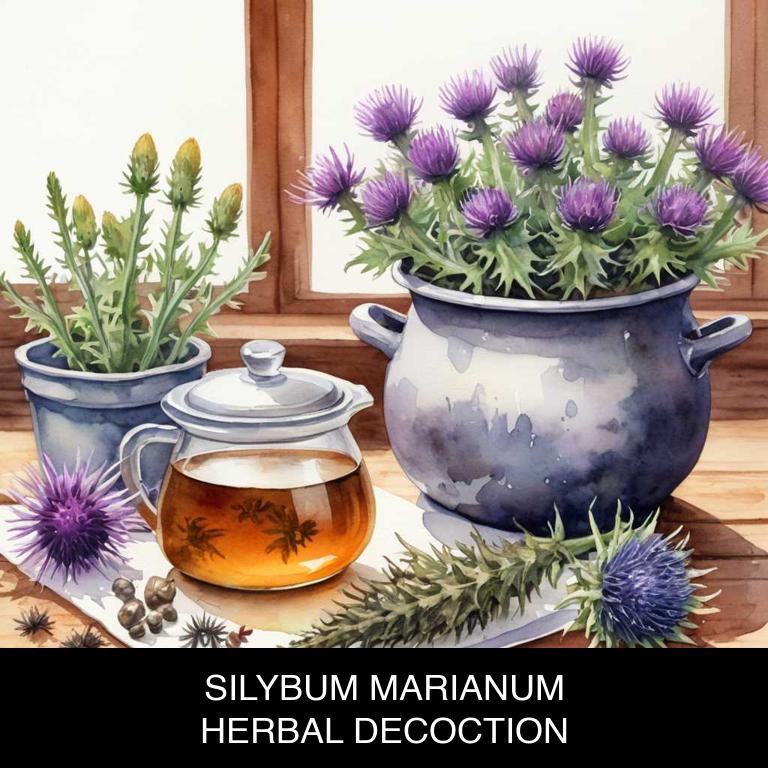
Medicinal Constituents
The list below shows the primary medicinal constituents in Silybum marianum decoctions that help with cirrhosis.
- Silymarin: It helps protect liver cells from damage and supports liver regeneration, reducing oxidative stress and inflammation associated with cirrhosis.
- Flavonoids: They have antioxidant properties that help scavenge free radicals, reduce liver inflammation, and improve liver function in individuals with cirrhosis.
- Silibinin: It has anti-inflammatory and antioxidant effects, which may help reduce liver fibrosis, prevent further liver damage, and promote the healing of liver tissue in cirrhosis patients.
Parts Used
The list below shows the primary parts of milk thistle used to make decoctions for cirrhosis.
- Seeds: The seeds of Silybum marianum are commonly used to make decoctions for cirrhosis because they are rich in silymarin, a compound with liver-protective properties.
- Flowers: The flowers of Silybum marianum are often used to make decoctions for cirrhosis due to their high concentration of silymarin, which helps to regenerate liver cells.
- Leaves: The leaves of Silybum marianum are sometimes used to make decoctions for cirrhosis because they are a good source of flavonoids and other bioactive compounds that support liver health.
Quick Recipe
The following recipe gives a procedure to make a basic milk thistle for cirrhosis.
- Harvest 30-60 grams of fresh silybum marianum leaves and flowers or 100-200 grams of dried silybum marianum flowers and leaves.
- Clean the silybum marianum flowers and leaves thoroughly to remove dirt and other contaminants from the plant material.
- Combine the clean silybum marianum flowers and leaves with 1 liter of water in a medium-sized pot.
- Bring the mixture to a boil then reduce the heat to a simmer for 30-60 minutes or until the liquid has reduced by half.
- Strain the decoction through a cheesecloth or a fine-mesh sieve into a clean container to remove the plant material.
2. Glycyrrhiza glabra
Licorice decoctions helps with cirrhosis because of its potent anti-inflammatory and antioxidant properties.
The glycyrrhizin present in licorice root has been shown to reduce liver inflammation and scarring, thereby slowing down the progression of cirrhosis. Additionally, the decoction's ability to improve blood flow and stimulate bile production can help alleviate symptoms such as jaundice and itching.
By reducing oxidative stress and promoting healthy liver function, licorice decoctions may help mitigate liver damage and promote overall liver health in individuals with cirrhosis.

Medicinal Constituents
The list below shows the primary medicinal constituents in Glycyrrhiza glabra decoctions that help with cirrhosis.
- Glycyrrhizin: It helps with cirrhosis by inhibiting the activity of 11-beta-hydroxysteroid dehydrogenase, an enzyme that converts cortisol to its active form, thereby reducing liver inflammation and promoting liver regeneration.
- Licopyranocoumarin: It helps with cirrhosis by exhibiting antioxidant and anti-inflammatory properties, which help to protect the liver from oxidative stress and inflammation caused by cirrhosis.
- Licoricidin: It helps with cirrhosis by modulating the immune response and reducing liver inflammation, which helps to slow down the progression of liver fibrosis and cirrhosis.
Parts Used
The list below shows the primary parts of licorice used to make decoctions for cirrhosis.
- Roots: The roots of Glycyrrhiza glabra are used to make decoctions for cirrhosis because they contain glycyrrhizin, a compound that helps reduce liver inflammation and improve liver function.
- Leaves: The leaves of Glycyrrhiza glabra are used to make decoctions for cirrhosis because they have anti-inflammatory properties that help alleviate liver inflammation and promote liver regeneration.
- Barks: The barks of Glycyrrhiza glabra are used to make decoctions for cirrhosis because they contain flavonoids and polyphenols that have antioxidant properties, which help protect the liver from damage and promote liver health.
Quick Recipe
The following recipe gives a procedure to make a basic licorice for cirrhosis.
- Harvest 20-30 grams of dried roots of glycyrrhiza glabra from a trusted supplier or grow your own in a controlled environment.
- Grind the dried roots into a fine powder using a mortar and pestle for efficient extraction.
- Combine the ground roots with 1 liter of water in a saucepan and bring to a boil over high heat.
- Reduce heat to a simmer and let the decoction steep for 15-20 minutes to allow for maximum extraction.
- Strain the decoction through a cheesecloth or a fine-mesh sieve into a clean container to discard the solids.
3. Taraxacum officinale
Dandelion decoctions helps with cirrhosis because they have been shown to improve liver function and reduce inflammation.
The antioxidants and polyphenols present in dandelion roots and leaves help to protect liver cells from damage, promoting regeneration and repair. Additionally, the bitter compounds in dandelion stimulate digestive enzymes, which can aid in the elimination of toxins that contribute to cirrhosis.
By supporting liver health and reducing oxidative stress, dandelion decoctions may help to alleviate symptoms and slow disease progression.

Medicinal Constituents
The list below shows the primary medicinal constituents in Taraxacum officinale decoctions that help with cirrhosis.
- Flavonoids: These compounds help with cirrhosis by exerting antioxidant and anti-inflammatory effects, which can reduce liver damage and improve liver function.
- Saponins: Saponins in Taraxacum officinale help with cirrhosis by reducing liver inflammation and improving liver detoxification processes, which can help to regenerate liver tissue.
- Polysaccharides: Polysaccharides in Taraxacum officinale help with cirrhosis by enhancing liver regeneration and improving the immune response, which can help to recover from liver damage and disease.
Parts Used
The list below shows the primary parts of dandelion used to make decoctions for cirrhosis.
- Leaves: Taraxacum officinale leaves are commonly used to make decoctions for cirrhosis due to their high content of taraxasterol and other bioactive compounds that help reduce liver inflammation.
- Roots: The roots of Taraxacum officinale are often used for decoctions to treat cirrhosis because they contain saponins and other flavonoids that may help improve liver function and reduce oxidative stress.
- Stems: Taraxacum officinale stems are also used to make decoctions for cirrhosis, as they contain flavonoids and other compounds that may help protect the liver from damage and promote its regeneration.
Quick Recipe
The following recipe gives a procedure to make a basic dandelion for cirrhosis.
- Harvest 10-20 fresh taraxacum officinale roots and clean them thoroughly under cold running water.
- Chop the roots into small pieces to increase their surface area for infusion.
- Combine 20 grams of chopped taraxacum officinale roots with 500 milliliters of cold water in a saucepan.
- Bring the mixture to a boil over high heat then reduce the heat to a simmer for 10-15 minutes.
- Strain the decoction through a cheesecloth or a fine-mesh sieve into a clean container.
4. Berberis aristata
Tree turmeric decoctions helps with cirrhosis because of its potent anti-inflammatory and antioxidant properties.
The curcuminoids present in turmeric have been shown to reduce liver inflammation, scarring, and fibrosis, which are common symptoms of cirrhosis. Additionally, the decoction's ability to improve blood flow and reduce oxidative stress may help alleviate symptoms such as jaundice and fatigue associated with cirrhosis.
Regular consumption of tree turmeric decoctions may also promote liver regeneration and repair, ultimately helping to manage the progression of this chronic disease.
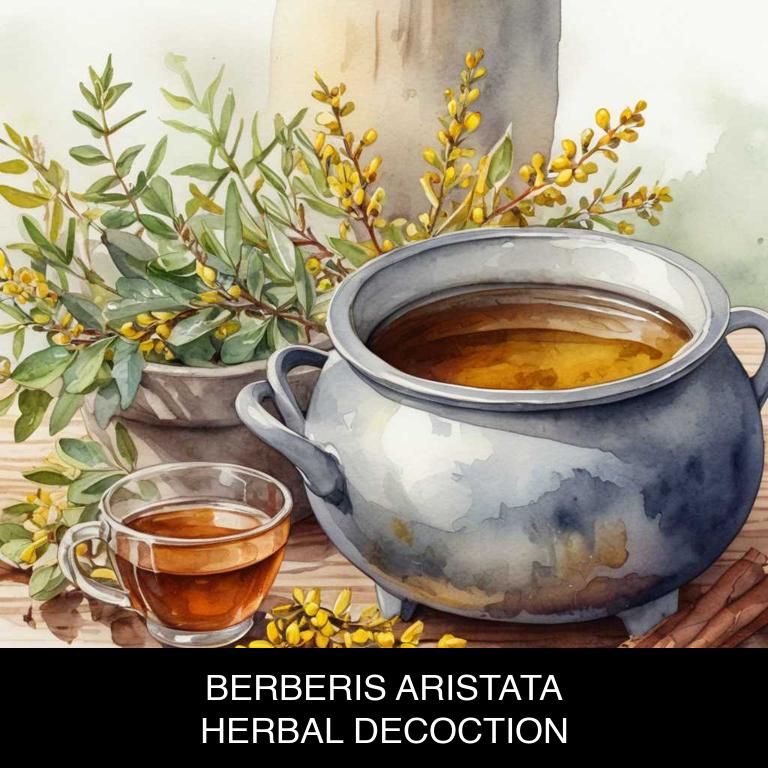
Medicinal Constituents
The list below shows the primary medicinal constituents in Berberis aristata decoctions that help with cirrhosis.
- Berberine: Berberine, an alkaloid, has anti-inflammatory and antioxidant properties that help reduce liver inflammation and oxidative stress associated with cirrhosis.
- Isoquinoline alkaloids: These alkaloids have hepatoprotective properties, which help protect the liver cells from damage and promote liver regeneration, thereby aiding in the management of cirrhosis.
- Flavonoids: Flavonoids in Berberis aristata decoctions exhibit antioxidant and anti-inflammatory activities that help mitigate liver damage and fibrosis, a hallmark of cirrhosis.
Parts Used
The list below shows the primary parts of tree turmeric used to make decoctions for cirrhosis.
- Roots: They contain berberine, a compound that helps to reduce liver inflammation and improve liver function.
- Barks: They have been used in traditional medicine for its potential to promote liver health and aid in the treatment of cirrhosis.
- Leaves: They are known to contain berberine, which may help to reduce liver damage and promote regeneration of liver cells.
Quick Recipe
The following recipe gives a procedure to make a basic tree turmeric for cirrhosis.
- Gather 30-60 grams of dried berberis aristata roots and clean them thoroughly with water.
- Crush the cleaned roots into fine powder using a mortar and pestle for better extraction.
- Combine 30-60 grams of the powdered root with 1 liter of water in a large saucepan.
- Boil the mixture for 20-30 minutes then reduce heat and simmer for 1-2 hours.
- Strain the decoction through a cheesecloth into a container and discard the solids.
5. Arctium lappa
Burdock decoctions helps with cirrhosis because it has been shown to improve liver function by reducing inflammation and oxidative stress.
The plant's active compounds, such as inulin and polyphenols, have been found to stimulate the production of glutathione, a powerful antioxidant that protects against liver damage. Additionally, burdock may help reduce fibrosis, a hallmark of cirrhosis, by inhibiting the production of collagen and promoting the breakdown of scar tissue.
By supporting liver health, burdock decoctions may slow or even reverse the progression of cirrhosis.
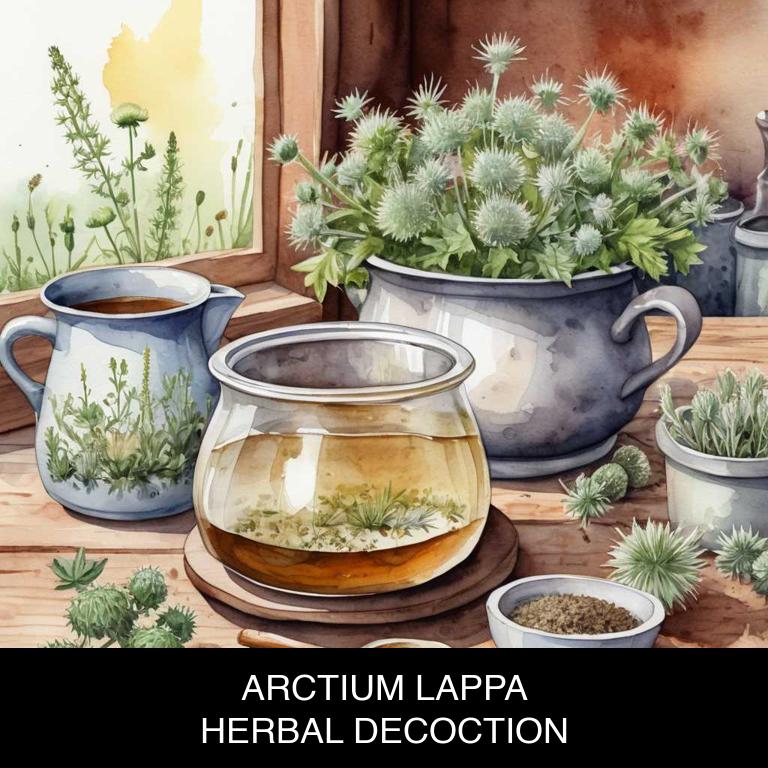
Medicinal Constituents
The list below shows the primary medicinal constituents in Arctium lappa decoctions that help with cirrhosis.
- Alkaloids: Alkaloids present in Arctium lappa, such as arctiin, have been shown to possess anti-inflammatory properties, which can help reduce liver inflammation and damage associated with cirrhosis.
- Phenolic acids: Ferulic acid, a phenolic acid found in Arctium lappa, has been reported to exhibit antioxidant and anti-inflammatory activities, which can help protect liver cells from oxidative damage and promote liver regeneration in cirrhosis.
- Flavonoids: Quercetin, a flavonoid present in Arctium lappa, has been found to possess anti-inflammatory and antioxidant properties, which can help reduce liver inflammation, prevent fibrosis, and promote liver cell regeneration in cirrhosis.
Parts Used
The list below shows the primary parts of burdock used to make decoctions for cirrhosis.
- Roots: Rich in mucilages and saponins, which help to soothe and protect the liver.
- Seeds: Contain various bioactive compounds, including arctiin and arctigenin, with hepatoprotective and anti-inflammatory properties.
- Leaves: Are a good source of flavonoids and polyphenols, which may help to reduce oxidative stress and inflammation in the liver.
Quick Recipe
The following recipe gives a procedure to make a basic burdock for cirrhosis.
- Gather 20 grams of dried arctium lappa root and 10 grams of dried arctium lappa leaves for the decoction.
- Combine the gathered arctium lappa root and leaves in a large pot with 2 liters of water.
- Bring the water to a boil over high heat then reduce the heat to a simmer for 20 minutes.
- Strain the decoction through a cheesecloth or a fine-mesh sieve into a clean container to remove solids.
- Allow the decoction to cool to room temperature then refrigerate or freeze for later use.
6. Plantago major
Plantain decoctions helps with cirrhosis because they contain antioxidants, flavonoids, and phenolic acids that have potent anti-inflammatory and antifibrotic properties.
The decoction's bioactive compounds can reduce liver inflammation and scarring, promoting regeneration and improving liver function.
Additionally, plantain decoctions may also help to improve digestion, reduce symptoms of liver disease such as jaundice, and even inhibit the growth of cancerous cells in cirrhotic livers, making it a valuable adjunctive treatment for this chronic condition.
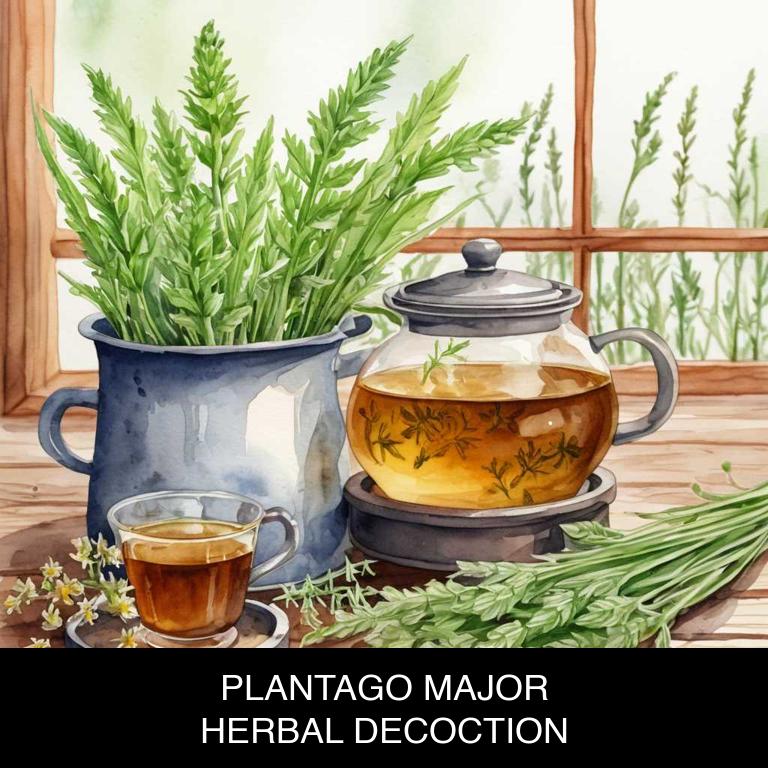
Medicinal Constituents
The list below shows the primary medicinal constituents in Plantago major decoctions that help with cirrhosis.
- Phenolic acids: Plantago major contains phenolic acids, such as ferulic acid and caffeic acid, which have been shown to possess antioxidant and anti-inflammatory properties, potentially helping to reduce liver inflammation and damage associated with cirrhosis.
- Apolypodine: Apolypodine, a saponin found in Plantago major, has been reported to have anti-inflammatory and hepatoprotective effects, which may help to mitigate liver damage and promote liver cell regeneration in patients with cirrhosis.
- Flavonoids: Flavonoids present in Plantago major, such as quercetin and kaempferol, have been found to possess antioxidant and anti-inflammatory properties, which may help to reduce oxidative stress and inflammation in the liver, potentially slowing down the progression of cirrhosis.
Parts Used
The list below shows the primary parts of plantain used to make decoctions for cirrhosis.
- Leaves: Used for their anti-inflammatory and antioxidant properties to help reduce liver inflammation and promote liver health.
- Seeds: Utilized for their hepatoprotective properties, which help protect the liver from damage and promote regeneration of liver cells.
- Roots: Employed for their bitter properties, which stimulate liver function, improve digestion, and help remove toxins from the body.
Quick Recipe
The following recipe gives a procedure to make a basic plantain for cirrhosis.
- Harvest 2-3 bunches of mature leaves of plantago major in the morning after the dew has evaporated.
- Dry the fresh leaves at 30-40°c for 2 hours to reduce moisture content and preserve them.
- Combine 2 teaspoons of dried leaves with 2 cups of water in a saucepan.
- Bring the mixture to a boil then reduce heat and simmer for 10-15 minutes.
- Strain the decoction through a cheesecloth or a fine-mesh sieve and discard the solids.
7. Galium aparine
Cleavers decoctions helps with cirrhosis because it has been traditionally used to support liver health by increasing bile flow and reducing inflammation.
The herb contains compounds that have antioxidant and anti-inflammatory properties, which help to protect the liver from damage and promote its natural detoxification processes.
Additionally, cleavers may help to reduce scar tissue formation and improve liver function in individuals with cirrhosis, leading to improved overall health and quality of life.
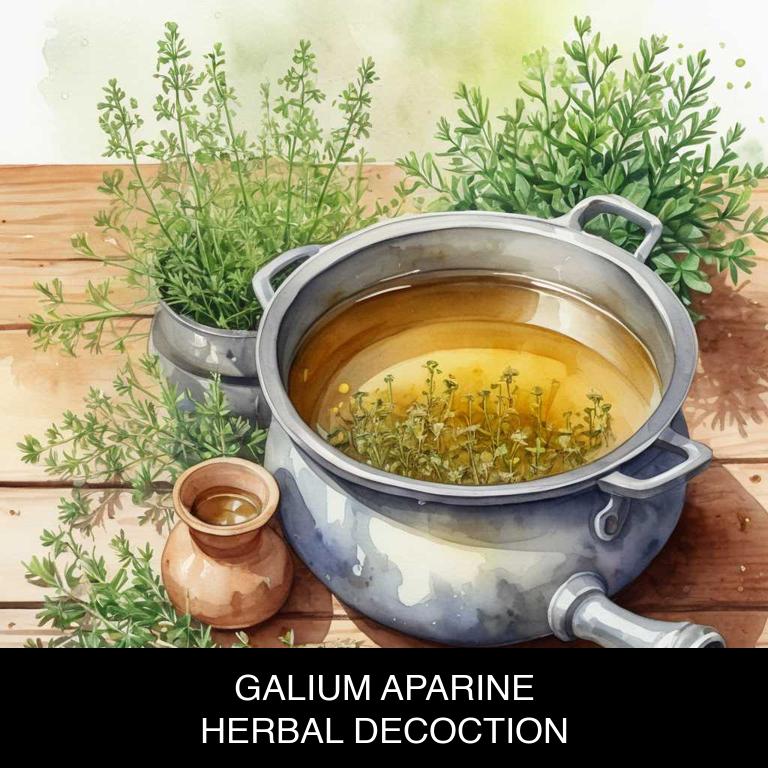
Medicinal Constituents
The list below shows the primary medicinal constituents in Galium aparine decoctions that help with cirrhosis.
- Tannins: Tannins in Galium aparine decoctions may help with cirrhosis by reducing liver inflammation and oxidative stress, which are common complications of cirrhosis.
- Flavonoids: Flavonoids present in Galium aparine decoctions may help with cirrhosis by inhibiting liver fibrosis and promoting antioxidant activity, which can slow down the progression of cirrhosis.
- Alkaloids: Alkaloids in Galium aparine decoctions may help with cirrhosis by reducing liver inflammation and modulating the gut-liver axis, which can improve liver function and reduce the risk of complications.
Parts Used
The list below shows the primary parts of cleavers used to make decoctions for cirrhosis.
- Leaves: They are rich in antioxidants, flavonoids, and other bioactive compounds that help reduce inflammation and promote liver health.
- Stems: The stems contain gallic acid and other polyphenols that exhibit hepatoprotective properties, aiding in the treatment of liver cirrhosis.
- Roots: The roots are a good source of flavonoids, alkaloids, and other compounds that help in liver detoxification and regeneration, supporting liver health.
Quick Recipe
The following recipe gives a procedure to make a basic cleavers for cirrhosis.
- Harvest galium aparine leaves and stems in early morning after dew has evaporated but before heat of day.
- Chop 30g of galium aparine into small pieces to release its bioactive compounds and essential oils.
- Combine chopped galium aparine with 500ml of boiling water in a heat-resistant glass container to make decoction.
- Simmer the mixture for 10-15 minutes to allow the bioactive compounds to infuse into the water.
- Strain the decoction through a cheesecloth or a fine-mesh sieve into a clean glass container to discard solids.
8. Echinacea angustifolia
Kansas coneflower decoctions helps with cirrhosis because of its potent antioxidant and anti-inflammatory properties.
The plant's active compounds, such as triterpenoids and flavonoids, have been shown to reduce liver inflammation and scarring, promoting healthy liver function. Additionally, Kansas coneflower has been traditionally used to support the body's natural detoxification processes, which can help alleviate symptoms associated with cirrhosis, such as fatigue and digestive issues.
By stimulating the body's natural healing mechanisms, herbal Kansas coneflower decoctions may provide a safe and effective means of managing liver disease.
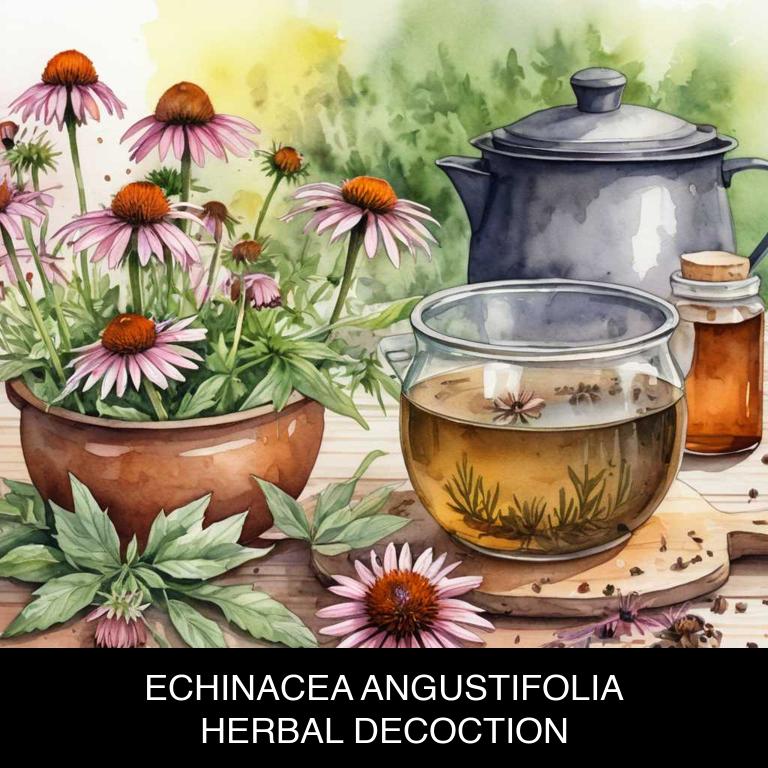
Medicinal Constituents
The list below shows the primary medicinal constituents in Echinacea angustifolia decoctions that help with cirrhosis.
- Iridoid glycosides: These compounds may help reduce liver inflammation and oxidative stress associated with cirrhosis by exhibiting antioxidant and anti-inflammatory properties.
- Alkylamides: They may aid in protecting the liver from damage by inhibiting the production of pro-inflammatory enzymes and reducing oxidative stress, which can contribute to liver disease progression.
- Polyacetylenes: These compounds may help to reduce liver fibrosis and inflammation by modulating the expression of genes involved in the inflammatory response and fibrogenesis, potentially slowing cirrhosis progression.
Parts Used
The list below shows the primary parts of kansas coneflower used to make decoctions for cirrhosis.
- Roots: The roots are used due to their high concentration of compounds that exhibit hepatoprotective properties, which help protect and repair liver cells.
- Leaves: The leaves are used because they contain compounds that have anti-inflammatory and antioxidant properties, which can help reduce liver inflammation and oxidative stress associated with cirrhosis.
- Barks: The barks are used due to their content of flavonoids and phenolic acids, which have been shown to have hepatoprotective effects and may help improve liver function in individuals with cirrhosis.
Quick Recipe
The following recipe gives a procedure to make a basic kansas coneflower for cirrhosis.
- Gather 20-30 grams of dried echinacea angustifolia roots from a trusted supplier.
- Crush the dried roots into smaller pieces using a mortar and pestle.
- Combine the crushed roots with 500ml of boiling water in a large saucepan.
- Simmer the mixture for 10-15 minutes over low heat with a lid on.
- Strain the decoction through a cheesecloth or fine mesh to remove the solids.
9. Solidago virgaurea
Goldenrod decoctions helps with cirrhosis because it has been traditionally used to reduce inflammation and improve liver function.
The antibacterial and anti-inflammatory properties of goldenrod help to eliminate toxins and scarring in the liver, which can alleviate symptoms such as abdominal pain, fatigue, and jaundice associated with cirrhosis.
Additionally, goldenrod's antifibrotic properties may help to slow or reverse the progression of liver fibrosis, a hallmark of the disease.
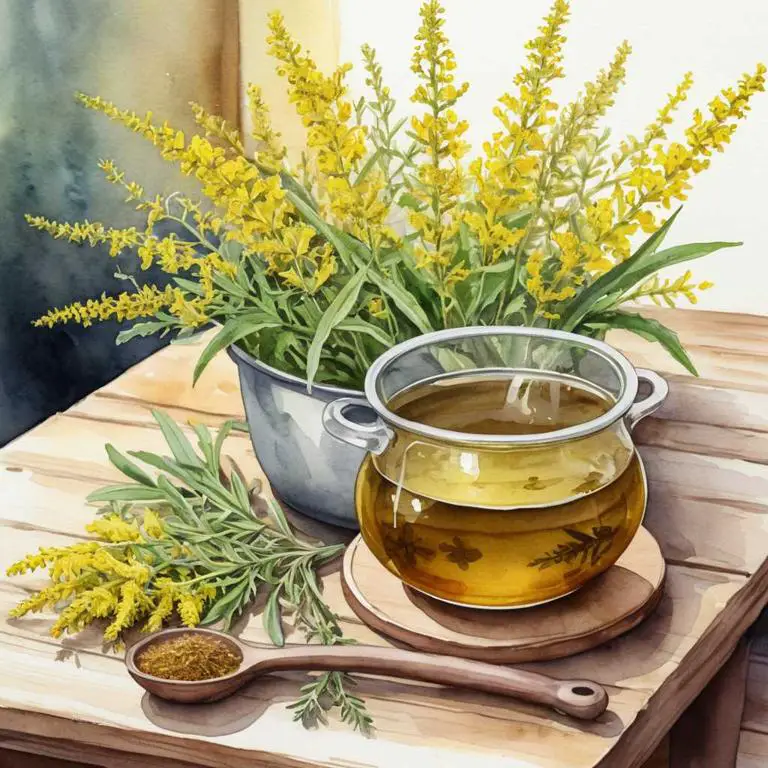
Medicinal Constituents
The list below shows the primary medicinal constituents in Solidago virgaurea decoctions that help with cirrhosis.
- Flavonoids: They have antioxidant and anti-inflammatory properties, which can help reduce liver inflammation and protect against oxidative damage associated with cirrhosis.
- Triterpenoids: They exhibit hepatoprotective properties, which can help repair liver cells and improve liver function, reducing the severity of cirrhosis symptoms.
- Phenolic acids: They have anti-inflammatory and antioxidant effects, which can help reduce liver inflammation and prevent further liver damage, slowing down the progression of cirrhosis.
Parts Used
The list below shows the primary parts of goldenrod used to make decoctions for cirrhosis.
- Roots: They are used due to their saponin content, which has been traditionally used to treat liver and digestive issues.
- Leaves: They are used because of their antioxidant and anti-inflammatory properties, which may help alleviate symptoms associated with cirrhosis.
- Stems: They are used due to their flavonoid and phenolic compounds, which have been shown to have hepatoprotective effects.
Quick Recipe
The following recipe gives a procedure to make a basic goldenrod for cirrhosis.
- Harvest solidago virgaurea roots and flowers in late summer or early fall when they are in full bloom.
- Dry the harvested solidago virgaurea roots and flowers in a warm dry place for several days to weeks.
- Measure out 1 part of dried solidago virgaurea roots and flowers and combine with 8 parts of water in a large pot.
- Bring the water to a boil then reduce the heat and simmer the solidago virgaurea decoction for 10 to 15 minutes.
- Strain the solidago virgaurea decoction through a cheesecloth or a fine mesh sieve into a clean container for storage.
10. Achillea millefolium
Yarrow decoctions helps with cirrhosis because of its unique ability to stimulate liver function, reduce inflammation, and promote blood flow.
The decoction's anti-inflammatory properties help alleviate symptoms such as pain, discomfort, and swelling associated with cirrhosis. Additionally, yarrow's antioxidant properties protect the liver from further damage by neutralizing free radicals.
By stimulating liver function, yarrow decoctions may also improve the body's ability to metabolize toxins, leading to a reduction in liver fibrosis and scarring.
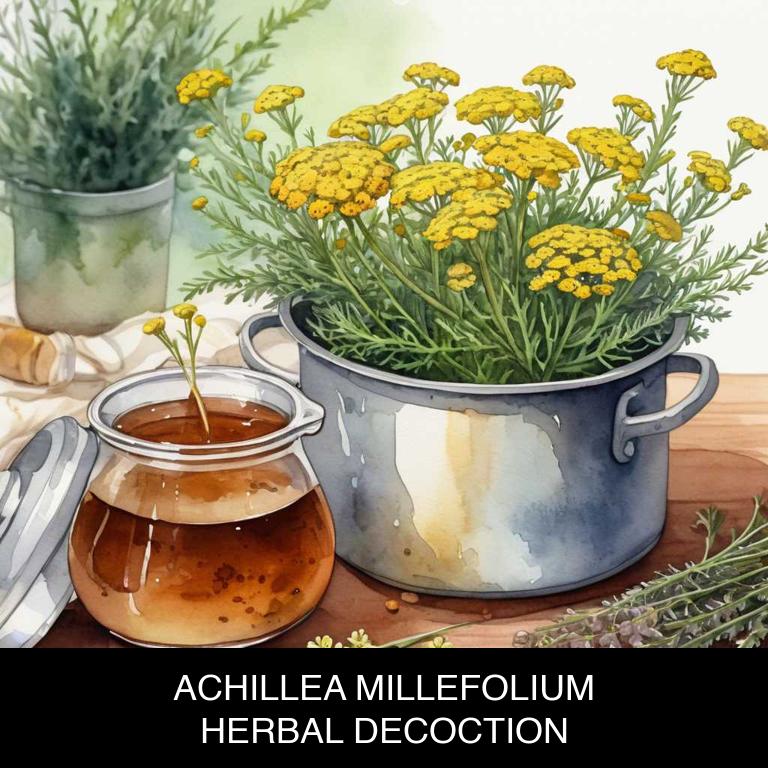
Medicinal Constituents
The list below shows the primary medicinal constituents in Achillea millefolium decoctions that help with cirrhosis.
- Apigenin: A flavonoid with anti-inflammatory properties that helps reduce liver inflammation and oxidative stress associated with cirrhosis.
- Luteolin: A flavonoid with antioxidant and anti-inflammatory properties that helps protect liver cells from damage and promotes liver regeneration.
- Chlorogenic acid: A phenolic acid with antioxidant and anti-inflammatory properties that helps reduce liver fibrosis and oxidative stress associated with cirrhosis.
Parts Used
The list below shows the primary parts of yarrow used to make decoctions for cirrhosis.
- Leaves: The leaves are used due to their high content of antioxidants and flavonoids, which help protect the liver and alleviate liver damage associated with cirrhosis.
- Roots: The roots are used due to their ability to stimulate liver regeneration and improve liver function, reducing symptoms of cirrhosis.
- Flowers: The flowers are used due to their anti-inflammatory properties, which help reduce liver inflammation and oxidative stress caused by cirrhosis.
Quick Recipe
The following recipe gives a procedure to make a basic yarrow for cirrhosis.
- Harvest fresh achillea millefolium leaves and flowers in the early morning when they are at their peak potency.
- Rinse the harvested plant material with clean water to remove dirt and debris thoroughly.
- Combine one teaspoon of dried achillea millefolium with one cup of boiling water in a heat-resistant container.
- Steep the mixture for 5 to 7 minutes to allow the active compounds to infuse into the liquid.
- Strain the decoction through a fine-mesh sieve or cheesecloth into a clean container to remove solids.
What is the best combination of herbal decoctions to use for cirrhosis?
The best combination of herbal decoctions that help with cirrhosis is a blend of milk thistle (Silybum marianum), dandelion root (Taraxacum officinale), and licorice root (Glycyrrhiza glabra).
Milk thistle's silymarin helps repair liver cells, dandelion root's anthraquinones stimulate liver function, and licorice root's glycyrrhizin soothes inflammation. These herbs have been traditionally used to support liver health and may aid in reducing liver damage associated with cirrhosis.
A balanced and consistent approach to herbal supplementation is essential for optimal benefits.
What ailments similar to cirrhosis are treated with herbal decoctions?
Ailments similar to cirrhosis/decoctions.html">cirrhosis/decoctions.html">cirrhosis that are treated with herbal decoctions are chronic liver diseases such as hepatic fibrosis, steatosis, and cholestatic disorders.
These conditions share similarities with cirrhosis in terms of liver damage and dysfunction.
Herbal decoctions made from plants like Milk Thistle, Turmeric, Dandelion, and Barberry have been used to reduce inflammation, improve liver function, and promote detoxification, which can help alleviate symptoms and slow disease progression.